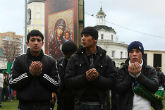
Many new immigrants from Central Asia learn Russian at special centres. Source: ITAR-TASS
If I had a penny for each time someone asked me how it feels to be a “person of colour” in Russia, I would be a multi-millionaire by now. This question comes from fascinated Dutch expats working in the Russian Far East, Americans from the Bible belt, where multi-racial friendships aren’t exactly the norm, and prospective Indian students to Russia who get easily swayed by exaggerated reports of violent crime in the country.
In ten years, not once have I been a victim of a racial assault or even racist verbal abuse in the country. There are times that I have been in the wrong neighbourhood and attracted unwanted attention since I stood out because of my physical features. I have always maintained that it’s very easy to fit into Russian society if one’s willing to take the first step and learn the language. However, many have argued that if it was that simple former Soviet citizens would be treated better in the country.
It would be too simplistic to say that there is growing xenophobia against people from Central Asia and the Caucasus. In 2013, the bogeyman from St Petersburg to Sakhalin is the Tajik. “Beware of Tajiks” was the buzz phrase I heard from one end of Russia to another last month. Over the last ten years, immigrants from far-away Tajikistan have come in large numbers to the oil and gas-rich island in the Russian Far East. I was warned against walking on the streets alone at night in Yuzhno-Sakhalinsk since muggings by Tajiks were allegedly common. A few years ago I would have dismissed such talk and the labelling of an entire community as racist rants from insecure people. But this time, the warnings came from the older and intellectual lot, from people who I believe don’t have a racist bone in their bodies.
Reports of crimes committed by immigrants don’t just appear on poorly sourced blogs anymore. Respected newspapers across the country publish articles about such crimes that are confirmed by the police. I read a report on ‘Sovetsky Sakhalin,’ a Yuzhno-Sakhalink-based newspaper, which said the police recently busted a large Tajik gang that was involved in a series of burglaries. There have also been disturbing increases in rapes and crimes against women in different parts of the country, where the perpetrators are believed from a Central Asian stan. This is no way means that all immigrants from these countries are potential criminals but having limited or no controls makes it easier for criminals to cross borders.
A senior Russian executive at a Sakhalin oil company put things in perspective. “It’s not the intellectuals of Dushanbe’s society that are coming to work in Russia,” he said, adding that larger geo-political strategic considerations were behind the virtually open-borders between Russia and the CIS countries. Of course China has managed to get a strong presence in the region, without opening its borders, but that’s an entirely different matter.

Fear rife among Russian middle class when it comes to immigration
The visa-free agreement with the former Soviet republics has led to an influx of blue-collar workers from these countries into Russia and yes, unfortunately, a large number of criminals. Having seen and heard first-hand, the genuine grievances of many of my close Russian friends, I think it would be foolhardy to dismiss anyone opposed to uncontrolled immigration as racists. An increasing number of people in Russia have genuine fears and these worries need to be addressed, rather than being brandished as irrational and xenophobic.
Igor Slyunyaev, Russia’s Regional Development Minister talked of plans to establish tolerance centres in the country in order to fight xenophobia. This is a welcome initiative but it’s equally important to have a planned immigration policy in the country. Instead of letting everyone in from some of the former Soviet republics, better entry formalities need to be put in place. Dmitry Medvedev recently said that the inflow of migrant workers is a trend that is “neither positive nor negative; it’s just life.” The prime minister agreed that the country needed to turn migration into a manageable process.
If Russia does need immigrants, then the new-comers first need to screened to ensure that no one with a criminal record enters Russia. Those that are let in must be sensitized about the culture and customs of the country. It’s equally important for the authorities to promote tolerance among the Diasporas in Russia towards the locals. Tolerance cannot just be a one-way street. Better informed and more tolerant immigrants would only add to the harmonious fabric of Russia, a country though overwhelmingly Slavic, still diverse and a melting pot of cultures and ideas.
Tailpiece:
The Soviet Union built thousands of factories after the Second World War in many of the Central Asian countries. It’s a shame that a large number of them have been shut or non-functional. Better management of these industrial units would lessen the need for economic migrants to look to Russia for opportunities. It may just be in Russia’s greater interests to help revive these factories.
All rights reserved by Rossiyskaya Gazeta.
Subscribe
to our newsletter!
Get the week's best stories straight to your inbox